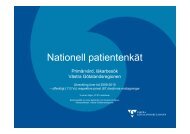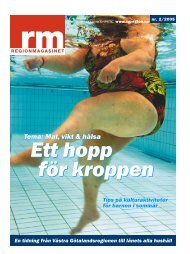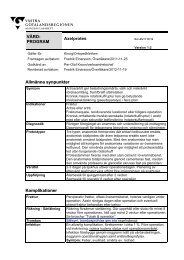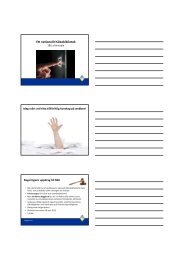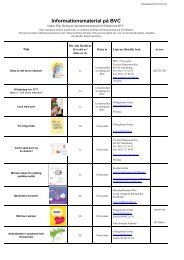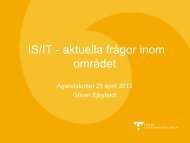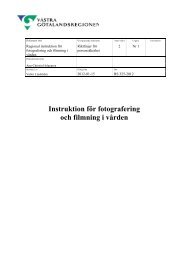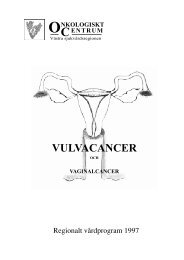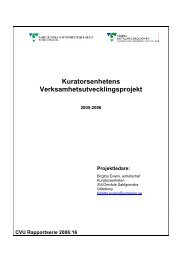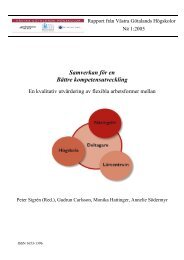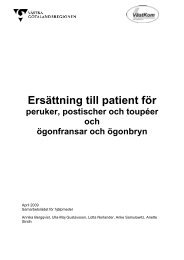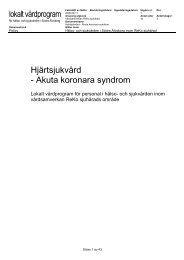FOURTEENTH ANNUAL EUROPEAN PRESSURE ULCER ...
FOURTEENTH ANNUAL EUROPEAN PRESSURE ULCER ...
FOURTEENTH ANNUAL EUROPEAN PRESSURE ULCER ...
Create successful ePaper yourself
Turn your PDF publications into a flip-book with our unique Google optimized e-Paper software.
Wednesday August 31st<br />
39<br />
14th Annual European Pressure Ulcer Meeting<br />
Oporto, Portugal<br />
ECONOMIC EVALUATION OF PREVENTION OF <strong>PRESSURE</strong> <strong>ULCER</strong>S IN INTENSIVE CARE UNITS<br />
Andrade, Melanie 1* , Nogueira, Fernanada 2 , Morais, Ernesto 3<br />
1* CHVNG/E, Portugal, andrade.melanie@gmail.com<br />
2 UTAD,Portugal 3 ESEP, Portugal<br />
Introduction<br />
The prevention of pressure ulcer assumes a fundamental role<br />
in health services economics and management, requiring the<br />
mobilization of material and human resources translated into<br />
significant costs for the institutions involved.<br />
As its aim this study had the determination and comparison<br />
of the costs and direct effects of pressure ulcer prevention<br />
with patients at risk of developing these ulcersm, admitted<br />
to two samples of an intensive care from different hospitals.<br />
Methods<br />
The methodology of this study was an economic evaluation,<br />
cost-effectiveness (CE), from the health institution view<br />
analysis, with patients admitted in intensive care units in<br />
two different hospitals CHVNG and in the HPH, between<br />
May and September 2009. The study population was 132<br />
patients (CHVNG) and 162 (HPH). The sample present<br />
inclusion criteria: patient without UP in admission moment<br />
and at risk of UP developing, with nursing intervention<br />
planed to prevent PU developing. The variables were related<br />
to the socio-biographical characteristics of patients, the costs<br />
of material and human resources recruited from the<br />
prevention PU programs and their direct effects (number of<br />
new cases, incidence and incidence density).<br />
Results<br />
The professional more important in prevention PU plan was<br />
the Nurse. We found that the samples had similar sociobiographical<br />
characteristics. They were hospitalized in ICU<br />
for around 6,7 days (CHVNG) and 5,9 (HPH). Diabetes is<br />
the predominant comorbidity in both samples. The patients’<br />
risk PU development was evaluated by Braden scale<br />
(CHVNG) and Norton scale (HPH). Considering the<br />
different risk PU development degree in each population,<br />
the difference between the averages of the daily frequency<br />
of the interventions for prevent PU development is not<br />
statistically significant. But, considering the two hospitals,<br />
the difference between the averages of daily frequency<br />
interventions was statistically significant - in the HPH,<br />
interventions were more frequently. Patients weren’t<br />
evaluated (using the scales) every days. The time of witch<br />
interventions, in the CHVNG was, for Position (position the<br />
patient, bed linen care) - 15 minutes, and in HPH - 19. For<br />
Monitoring scale was estimated 1,8 min in the CHVNG and<br />
5,87 min in HPH. Application of cream and massage was<br />
similar in both hospitals, 5,5 min in CHVNG and 5,9 in<br />
HPH.<br />
The total cost of PU prevention estimated was €20.915,36 in<br />
CHVNG and €42.100,69 in HPH. The cost of PU prevention<br />
per patient per day of hospitalization in ICU was €30,27 and<br />
€65,12, correspondingly. The human total cost represented<br />
almost 83% of the total cost, material/consumable (gloves,<br />
cream, apron and mask) 16% and material/equipment<br />
(mattress and pillows)



